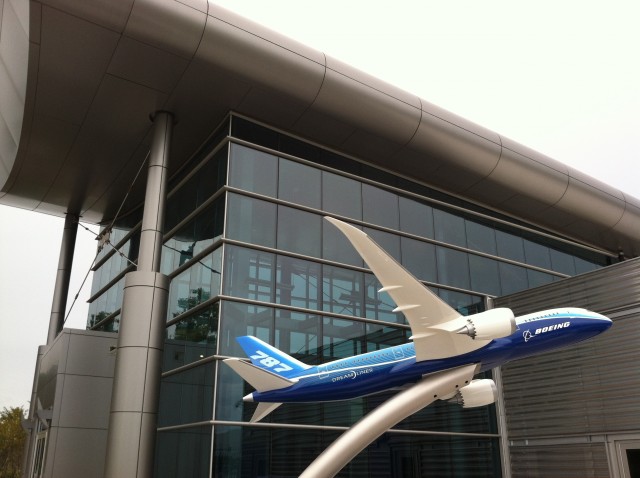
A model of the Boeing 787 outside the Visitor Center in South Carolina. Check out the wing-like roof.
This is a guest post written by Drew Vane for AirlineReporter.com:
I recently visited a Boeing Factory. No, I’m not talking about Renton or Everett, but in South Carolina.
Covering almost 11 football fields and completed in mid 2011, Boeing’s ’œother’ factory for manufacturing the new 787 Dreamliner is located in North Charleston, South Carolina on property bordering Charleston International Airport and Joint Base Charleston. I had the opportunity to stop by during a business trip recently and let me tell you, this facility is impressive. According to Boeing’s web site, ’œBoeing South Carolina fabricates, assembles and installs systems for aft (rear) fuselage sections of the 787 Dreamliner and joins and integrates mid-body sections from other partners.’
These partners include companies located in India and Japan. While I wasn’t able to tour the facility during my trip, I did take a short visit to the visitor’s facility and grabbed some pics of the lineup near the fence line. I just happened to miss the second 787 Dreamliner to depart for India by only one day. I also missed the departure of the Dreamlifter with its precious cargo bound for Seattle, but I hope to catch one in the future.
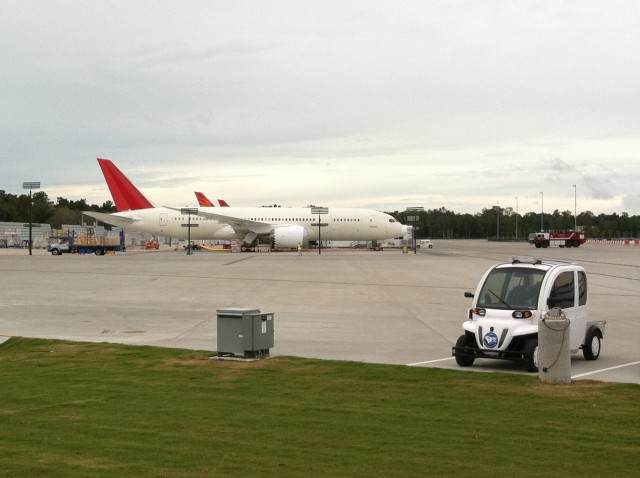
Some 787s on the tarmac at Boeing’s South Carolina facility. Image by Drew Vane.
Since green is the name of the game these days, Boeing designed this facility to be as environmentally friendly as possible. The final assembly building was fitted with solar panels that are capable of generating enough electricity to power 250 homes with a peak energy output equal to 200,000 13-watt watt bulbs. In addition, Boeing has a zero waste program where recycling and reuse is the norm, creating zero waste to landfills from the facility as a whole. Quite impressive for such a large manufacturing facility.
The visitor’s center unfortunately is for those with permission to enter the site. I had hoped to see a retail store, room full of Boeing paraphernalia and models for sale. It is too bad that the store is behind the fence, far from public eyes. The visitor center is more a front gate for those seeking security badges or meeting Boeing employees. They did have a very nice facility with a roof in the form of a 400-ft long wing, an outside small display with the history of Boeing, and a large scale model of the 787.
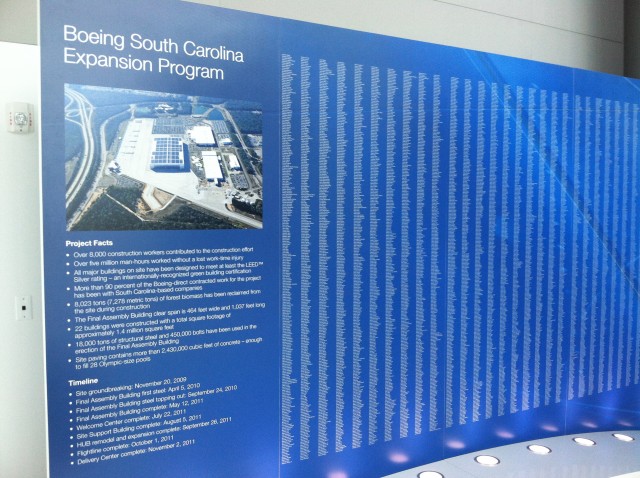
Boeing workers who built the facility
A very courteous Boeing employee was kind enough to talk with me as he was leaving for the day. Boeing’s Charleston facility is the only location currently in the world where the 787 tail assembly is manufactured. Boeing ships the tails to Everett where they’re assembled. Similar to Everett, all the parts are shipped here to Charleston for assembly. At the present time, Boeing’s manufacturing is only capable of producing one 787 per month. But, they hope to eventually ramp that up to one every six days, similar to the Everett Washington facility.
From public areas, I did spot some red tails (not the movie) in the lineup area and took a drive over, stopping outside the fence to snap a pic of the lineup. What an impressive sight! I was excited just to be in the same state as these fine aircraft. I cannot wait until my next visit.
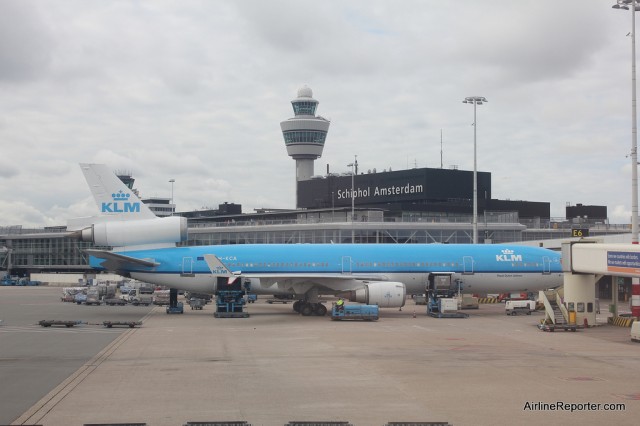
An MD-11 in KLM livery at Amsterdam (AMS).
This is a guest story by Drew Vane on the classic MD-11.
In July of this year, KLM started retiring their fleet of MD-11s with plans to replace them with more fuel efficient aircraft. “Phasing out the MD11 forms part of KLM’s ongoing fleet renewal programme,” a KLM spokesperson explained to AirlineReporter.com. “The last of KLM’s ten MD11s is expected to leave the fleet by the end of 2014.” For the long term, KLM plans to replace the MD-11s with 787-9s, but until then, they will Boeing 777s and Airbus A330s.
In my last article, I highlighted the DC-9 and its impending departure from the commercial skies. I’d thought its time was coming to a close, but Delta surprised me by extending the DC-9’s usage an additional year, but it looks like KLM won’t be delaying their MD-11 retirements.
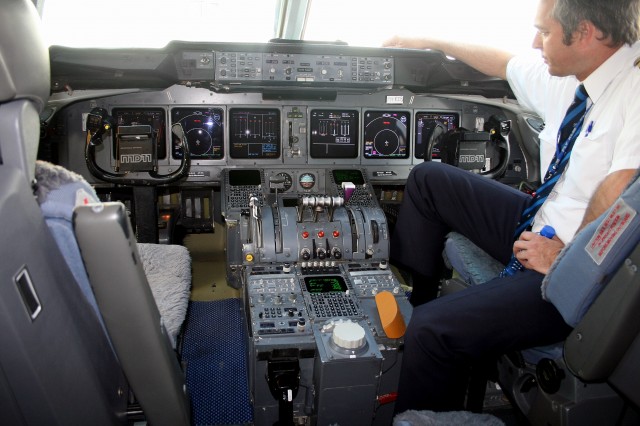
The flight deck of a KLM MD-11 (PH-KCB). Photo by Dave H.
Once KLM phases out the MD-11, there will be no other commercial airline flying this widebody tri-jet for scheduled passenger service. It’s anticipated that only few cargo and charter airlines will use the MD-11 in their fleet before disappearing from the sky forever.
The MD-11 came about when the aviation engineers at McDonnell Douglas decided an upgrade to the DC-10 was warranted. Instead of inventing a new aircraft, McDonnell Douglas took an already existing popular wide-body aircraft, whose biggest user and launch customer was American Airlines, and made it better.
The DC-10 was plagued with poor media attention due to some catastrophic failures in the 70’s and 80’s, including the worst commercial air disaster in US history, the loss of American Airlines Flight 191. With that flight, a DC-10 rolled over following takeoff and crashed in Chicago on May 25, 1979 which resulted in 270 deaths.
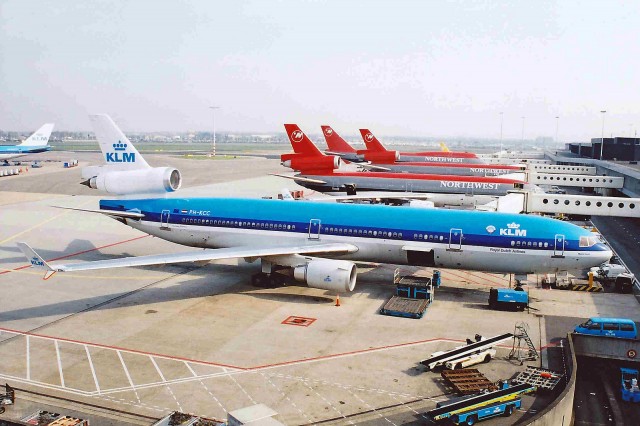
KLM MD-11 at AMS with Northwest DC-10s in the background. Image taken in 2001 by Ken Fielding.
New technological advances had a major impact on what led to the DC-10 Super 60 project, what would eventually become the MD-11. Boeing’s website best describes what exactly made the MD-11 better than its predecessor. Specifically it states that the MD-11 has ’œadvances in aerodynamics, propulsion, aircraft systems, cockpit avionics and interior design.’ What does all the mean? Well, a leaner and meaner version of the DC-10. Here is a summary of the modifications:
- Advanced Cockpit: Fly-by-wire technology, CRT displays, dual flight management system computer (eliminates need for a flight engineer), hydraulic fuses to prevent loss of control in catastrophic conditions, central fault display system, GPS, and Cat III automatic landing capability for extremely bad weather.
- Composite Materials: Usage of light weight composites reduced overall weight and allowed for a fuselage 40 feet longer than the DC-10.
- Aerodynamic design: Added winglets produce 2.5% more efficiency in drag as well as wing and tail improvements.
- More efficient engines: More efficient aircraft engines were developed by Pratt & Whitney, GE and Rolls Royce. New engine types resulted in greater thrust as less fuel usage and longer range.
The table below highlights how these improvements directly related to a longer range and more efficient aircraft. To make things apples to apples, I’ve chosen versions that were the best of each aircraft type.
|
DC-10-30
|
MD-11 ER
|
| Cockpit Crew |
3
|
2
|
| Passengers (3-class) |
255
|
293
|
| Passengers (2-class) |
285
|
323
|
| Maximum Range (full load) |
6,600 mi
|
7,240 mi
|
| Maximum Cruise Speed |
Mach 0.88
|
Mach 0.88
|
| Maximum Takeoff Weight |
572,000 lbs
|
630,500 lbs
|
| Maximum Fuel |
36,650 gallons
|
38, 615 gallons
|
| Engines – Thrust |
PW4462 – 62,000 lbf
|
PW JT9D-59A – 53,000 lbf
|
| Fuselage Length |
170 ft
|
192 ft
|
| Wingspan |
165 ft
|
169 ft
|
So, what we have is a longer range aircraft that is capable of carrying more passengers with less crew and a state-of-the-art cockpit.
If you want to catch a ride on one of these ’œMighty Dogs’ after KLM retires their 9 remaining aircraft, short of buying your own, you’ll have to fly on a charter flight or ship yourself via Fedex, UPS, Eva Cargo or Lufthansa Cargo.
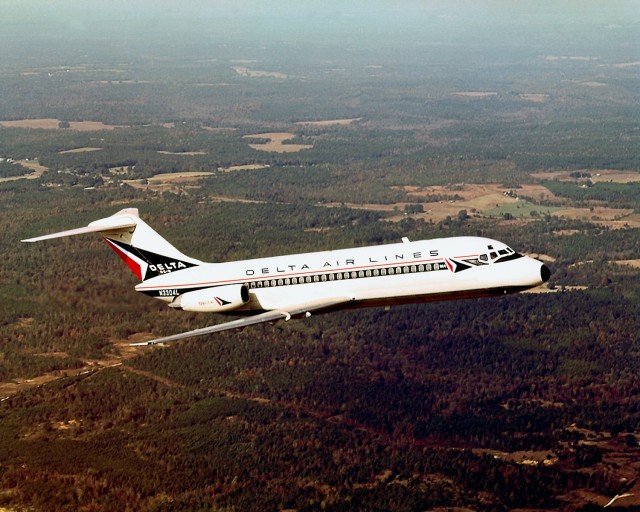
DC-9 “Delta Prince” in flight over wooded area, taken in the 1960’s. Image courtesy of Delta Air Lines.
This Story was Written by Andrew Vane for AirlineReporter.com:
Last summer I had the pleasure of writing an aircraft highlight article on the Mad Dogs and their history which began with the DC-9 and has brought us to the Boeing 717. About a year ago, Delta Air Lines, one of the last US airlines still operating the DC-9’s, announced that they would be retiring the last remaining 35 DC-9-50’s over the next 12-18 months. As of September 2011 the number of DC9’s in use was down to about 27.
In Fall 2011, I realized that I had to plan a business trip to Nashville from Charlotte for a national conference related to my work. While air travel is not usually a part of my work, I really enjoy choosing flights based on aircraft within my travel window, not only for comfort but for the experience. What I realized for this trip is that the Charlotte to Atlanta flights and Atlanta to Nashville flights afforded a wide selection in aircraft type from the telephone booth sized CRJ’s to the A319 and MD-88’s. What’s this? There are DC-9’s on that route?
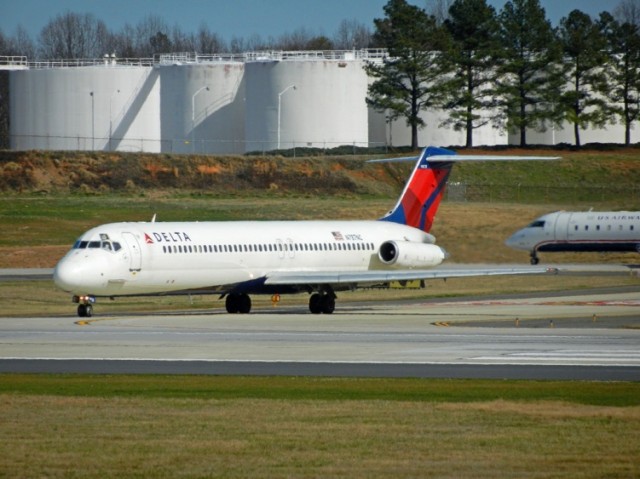
Delta DC-9 taxis onto Runway 18C at Charlotte, NC. Photo by Andrew Vane.
This means I have an opportunity to actually fly in what’s likely to be a museum piece in the near future. I suddenly realized I had to jump on this opportunity to ride this workhorse of the short range market before the opportunity is gone. As it turns out, I managed to book 3 of my 4 flight legs on the glorious DC-9-50. Only my Atlanta to Nashville flight would be on a different aircraft; the Airbus 319) The table below highlights the aircraft I was privileged to fly in for this trip:
| Flight Leg |
Aircraft Type |
Registration |
Year Built |
| Charlotte-Atlanta |
DC-9-50 |
N675MC |
1975 |
| Atlanta-Nashville |
Airbus A319 |
N302NB |
2000 |
| Nashville-Atlanta |
DC-9-50 |
N767NC |
1977 |
| Atlanta-Charlotte |
DC-9-50 |
N784NC |
1978 |
The DC-9 first entered service in 1965 with Delta as the launch customer. Delta eventually phased out the DC-9’s but reacquired them (along with Boeing 747’s and Airbus A319, A320 and A330’s) when it merged with Northwest Airlines in 2008.
I’ve been excited about this trip ever since I booked it last month with my company’s travel agent. If you’re looking for a luxurious flight experience, this aircraft is not the place to find it. Hopefully this article will contrast with the web site founder’s exotic meal laden VIP trips the rest of us common folk can only dream of taking. J My previous story on the Mad Dogs drew some comments regarding the smell of the lavatory wandering throughout the cabin. I sat right over the wing and couldn’t even smell a hint of the lavs. I could see every single rivet and bolt on the wing though.
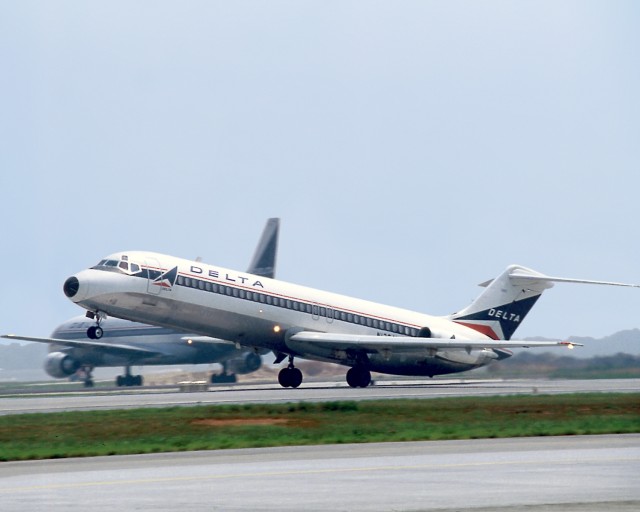
Delta DC-9 in updated livery. Check out the L1011 in the background. Image courtesy of Delta Air Lines.
As I strapped myself in, I couldn’t help but notice how modern the interior of Delta’s DC-9’s look. They’ve spared no expense in making you feel business as usual on all their aircraft, whether they’re 10 years old or 30. The captain came on and told us he was going to be starting the engines at the gate and that the lights would flicker a bit while he ran through some electrical checks. I almost expected to see some guy come out with a hand crank. I’m not sure if the gate startup is because they need ground power or for some other reason.
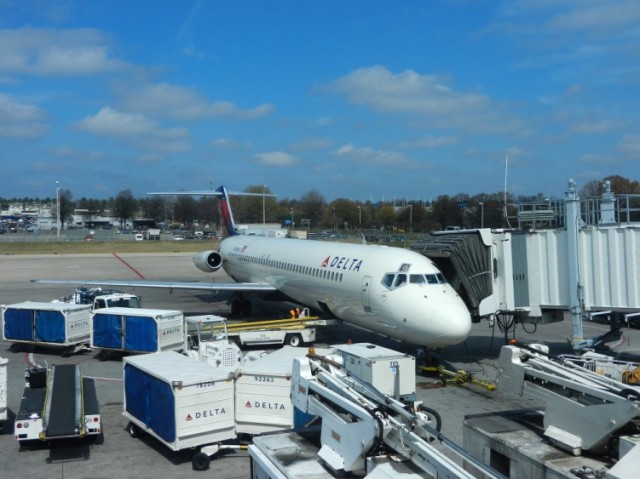
DC-9-50 at Delta’s gates in Charlotte, NC. Photo by Andrew Vane.
The DC-9 uses Pratt & Whiney JT8D turbojet engines with about 16,000 lbs of thrust each, the same type used by the 727, MD-88 and early versions of the 737. By contrast, the Airbus 319 uses European made CFM engines each are rated at 25,000 lbs of thrust each. I was thankful Charlotte has a 10,000 foot long runway because I figured we’d be needing all of it that day.
As expected, as we began our takeoff roll, I noticed it was taking quite a long time to get down the runway. It took a good 40 seconds to go from a rolling start to the hind wheels leaving the pavement. By comparison, the similarly sized A319 took 30 seconds to takeoff, but that was from a dead stop. The difference between engine thrust in the two aircraft was obvious. Still, the rumble in the DC-9 was definitely more fun an experience.
The flight went smoothly, the air conditioner worked, and we arrived right ’œon time,’ although I think the airline adds to the official travel time to allow for ground traffic and taxiing.
At the time of my travel in March, Hipmunk.com (an airline travel web site I frequent) showed Delta’s last DC-9 flights between Charlotte and Atlanta ending June 6th (being replaced with its longer MD88 cousin) and DC-9 flights from Atlanta to Memphis ending sometime in early October (being replaced with MD88’s and A319’s). However, one Delta pilot who took a lot of time after my first flight answering my questions told me Delta plans to fly DC-9’s at least for an additional year and plans a DC-9 ’œjet base’ for pilots in Atlanta. For now, I can postpone my farewell for at least another year or so.
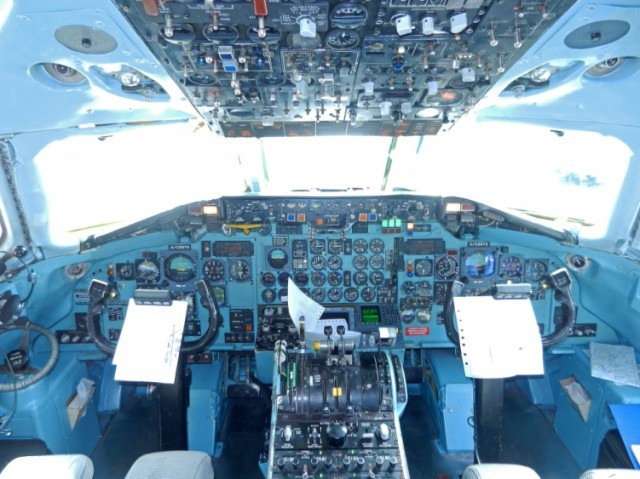
Teal Anyone? No FMC here. Its old school flying for sure.
Some of you fliers may enjoy the comfort and luxury of the newer aircraft. As I get older, I’m becoming more nostalgic and appreciating the older classics in life like a fine Merlot, Vivaldi and the DC-9.
I want to express my sincerest thanks to the Delta pilot Mark who took time to talk with me following each flight. My former landlord, a Delta 757 pilot, told me once after sitting in the jump seat of a DC-9 ’œBoy, those guys sure do work!’ Unlike the MD-80 series, the DC-9’s never received a cockpit upgrade. The pilots use nothing but the original steam gauges and fly VOR to VOR. While the newer aircraft with FMC’s let the aircraft fly the needle during cruise, the DC9 pilots often don’t know they’re off course until its too late. One pilot shared this with me and said he’d sometimes received ’œwhere are you going?’ questions from ATC after straying a bit off the route. ’œIf you’re within 4 miles you’re good,’ he told me.
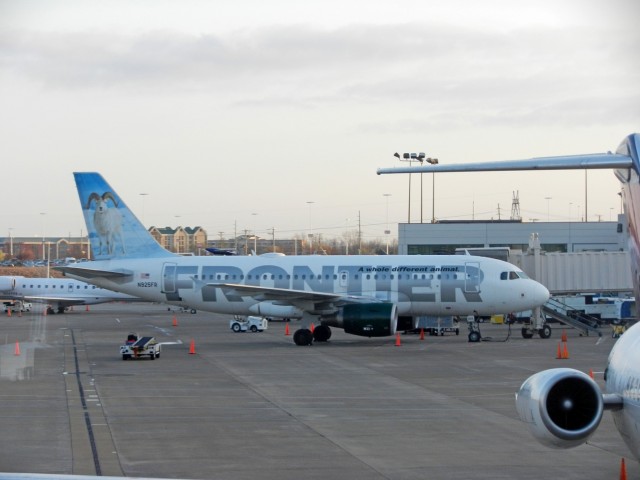
An Airbus 319 in Nashville giving new meaning to the term ’œRam Jet’. Photo by Andrew Vane.
This week’s airline livery comes from Drew Vane. Here is his story in his own words:
If ever there was an airline livery for animal lovers, it’s Frontier Airlines. If you’ve happened to fly anyplace west of the Mississippi, chances are you’ve seen the wildlife friendly tails.
Every since Frontier Airlines announced the “new” re-branded name after merging with Midwest, the airline has continued to wow passengers with their tails, even if the animals painted on them don’t always have them. Not only are these aircraft beautiful works of art, they’re also all unique to each individual aircraft. Be it a regional jet or turboprop flying under Frontier Express or an Airbus A320 series for the main airline, Frontier has as many liveries as it does aircraft. I suppose you could say its got more liveries than any other airline. They even recently had a voting option for the next tail animal with Polly the Parrot pulling in 39% of the vote.
As a wholly owned subsidiary of Indianapolis based Republic Airways Holdings, Frontier Airlines has rapidly grown in its 18 year history to reach 80 destinations from its hubs in Denver, Milwaukee and Kansas City.
I haven’t had the privilege of flying on Frontier but I did catch a glimpse of some of their fleet in Nashville last month. Airline Reporter featured both the Fox and Bald Eagle in past stories. I think they should do away with the traditional N registration numbers mandated by the FAA and register their aircraft with the mascot’s name. I can just hear the pilots on the radio: ’œFrontier Polly want an approach cracker.’
How many animals have you flown on and what are your thoughts on this livery?
Drew Vane has written a few posts for AirlineReporter.com and his most recently one takes an inside look at FlightAware.com after speaking with their CEO Daniel Baker. Many aviation fans use this tool to follow planes flying around the United States. Here is his story in his own words:
As some of you fine aviation enthusiasts may be aware (pun fully intended), a handly little website called FlightAware.com has been quietly making headlines as a source for tracking flights real-time (well, almost real time). The site provides info on airport delays, weather, flight routes, and updated flight status.
If you have any interest in aircraft and air travel, this web site is for you. According to FlightAware CEO Daniel Baker, ’œFlightAware was founded with the goal of providing flight tracking to pilots of general aviation aircraft in the United States. It wasn’t long before that goal grew to include flight departments, dispatchers, airport operators, and private aircraft passengers. We’re now involved in worldwide airline operations, consumer flight tracking of airline flights, and more. FlightAware has over 3,000,000 monthly users of the free web site and over 2,500 commercial customers that use FlightAware in an operational or research capacity.’
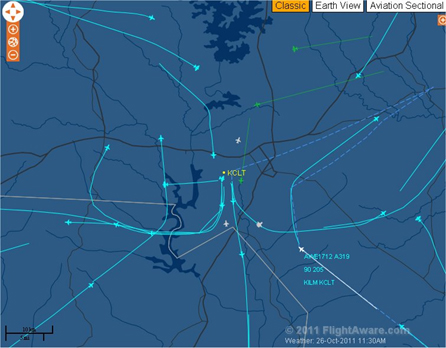
South Ops in Charlotte: Just put your cursor on an aircraft and it will give you the flight number, aircraft type, flight level, speed and origin/destination.(Image used with permission).
How does a simple web site get all this info? According to the web site, ’œFlightAware compiles, aggregates, and processes data from a variety of government sources, airlines, commercial data providers, as well as FlightAware’s proprietary flight tracking network.’ In other words, its all public domain and some skilled web programmers have developed a system to let the common person see accurately where domestic (and now international) flights are headed within a 5-minute window.
Since its inception in 2005, FlightAware has added new features regularly including mobile apps. What started as a small business with a handful of executives has grown to 25 employees with offices in both Houston and New York City. FlightAware even has a company store and is giving something back to support Breast Cancer Research.
Although great, FlightAware is far from perfect. Recently, I tried to track my friends flight from O’Hare to Virginia Beach which was experiencing bad weather. After two go-arounds his flight diverted to Raleigh. Flightaware only showed a couple loops around the airport but did not show the flight continuing on. In addition, it showed his flight on the O’Hare departures list twice with one flight cancelled. Perhaps this is a programming hiccup since the original flight was not completed. The flight to Raleigh never did show up on the web site, but I wouldn’t depend on flightaware over a phone call to check on loved ones travelling.
Flightaware currently has over 1.2 million registered members and that number is growing at a rate of 30,000 to 50,000 new users per month. CEO Daniel Baker shared with me that, ’œthe rate of airline travelers adopting the site means that it’s our biggest growth area and certainly they’ll eclipse pilots in the long term. That said, we continue to focus on our roots and will be providing great service to the aircraft operators that use FlightAware operationally.’ With so much already to offer, and a price that’s hard to beat, I’m excited to see what this web site and business will share with us airline nerds in the future.
Here are some of my favorite links to follow of popular aircraft:
* Airbus A380’s
* Donald Trump’s New 757
* Michael Jordan’s Gulfstream IV
* Roush-Fenway Racing’s 727
* Boeing’s 787 Aircraft ZA001
* The new Honda-Jet












